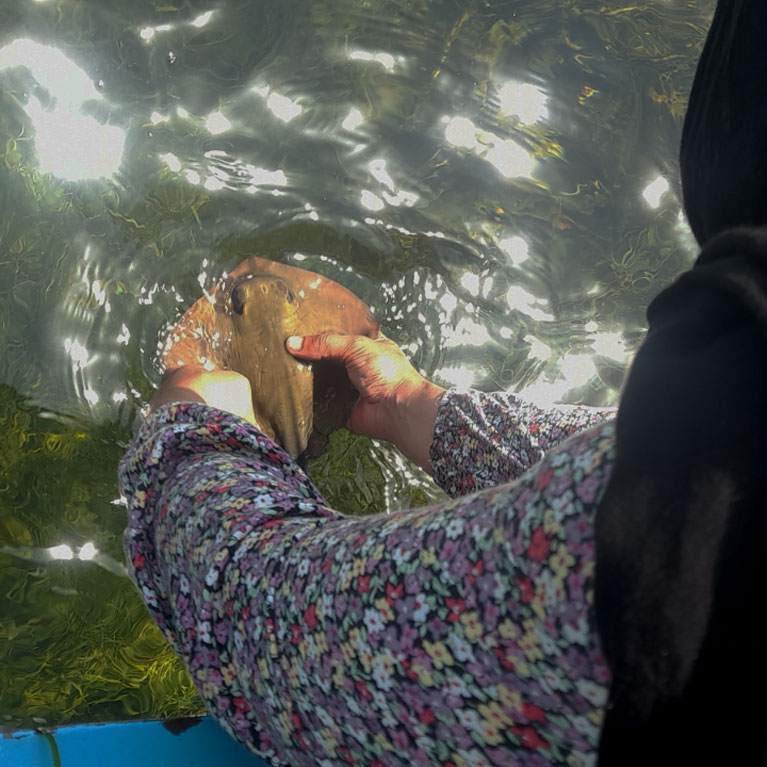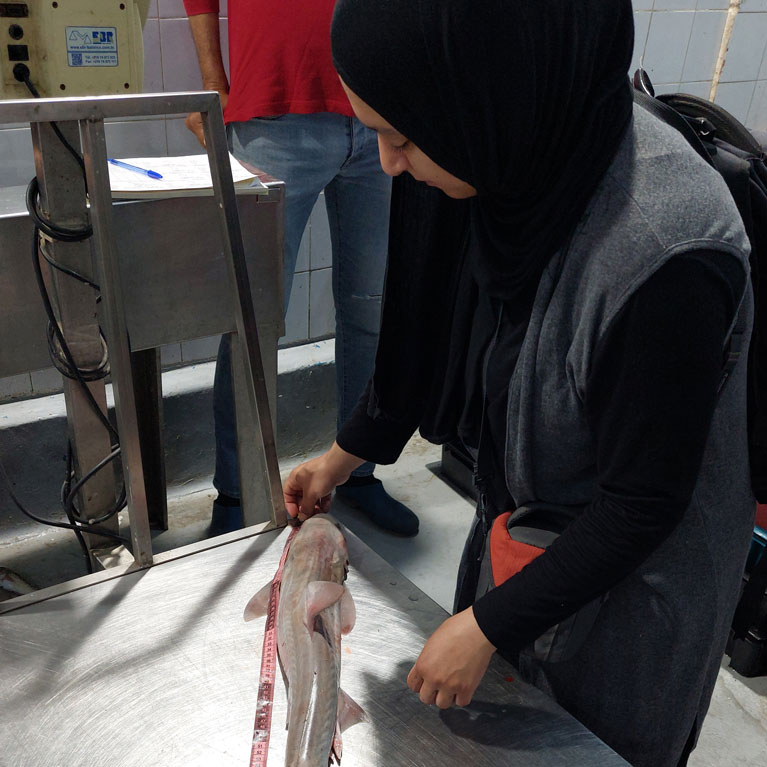Where are sharks and rays gathering in the Gulf of Gabès?
The Gulf of Gabès is a biodiversity hotspot in Tunisia where fisheries targeting sharks and rays operate during spring and summer. And it seems that fisheries are operating in nursery grounds – a concern that Rihab wants to clarify. She is using baited remote underwater video system (BRUVs) surveys to gather data on critical habitats and confirm aggregation areas for sharks and rays. Using the information she gathers, Rihab will help bolster conservation efforts in the region, raise awareness of conservation issues with fishers and promote sustainable practices to ensure that if fisheries are viable, so is the long-term health of shark and ray populations.
I am a PhD researcher in marine biology at the Faculty of Science of Sfax and a member of the Marine Biodiversity Laboratory of the National Institute of Marine Sciences and Technologies (INSTM). My studies began with an undergraduate degree in natural sciences in 2018, followed by a Master’s in biodiversity of organisms, populations and environment in 2020. Choosing this particular course relates to my passion for nature and marine ecosystems. Given the problems that face the marine environment, I chose to work on species that are both iconic and endangered: sharks and batoids. I have been studying...


Saving Sandbar Sharks and Guitarfishes in the Gulf of Gabès
The primary objective of my project is to confirm the aggregation zones of elasmobranchs in the Gulf of Gabès. This will involve monitoring fishing activities and using BRUV (baited remote underwater video) systems to assess species abundance in these areas.
There is an urgent need to conserve shark species in the Gulf of Gabès, a region recognised as a biodiversity hotspot. By confirming aggregation zones using BRUV systems – an approach being implemented in the Gulf of Gabès for the first time – we can gather essential data to guide conservation efforts. This information will help protect critical habitats and promote sustainable fishing practices, ensuring the survival of vulnerable species.
The Gulf of Gabès, a crucial marine ecosystem on the south-eastern coast of Tunisia, is known for its diverse marine life, particularly sharks and rays. In this area, fisheries targeting sharks and batoids operate seasonally during spring and summer. However, these fisheries target endangered species such as the sandbar shark Carcharhinus plumbeus and guitarfish, raising significant conservation concerns.
Preliminary data indicate that these fisheries operate in elasmobranch nursery grounds without effective management, leading to a decline in several populations. Protecting these grounds is critical for ensuring healthy levels of recruitment and the overall viability of the populations.
Our project aims to address this urgent conservation challenge by confirming key aggregation zones based on results from our previous research. We will estimate species abundance and biodiversity within these areas, using a combination of traditional onboard monitoring and BRUV systems. The use of BRUV systems in the Gulf of Gabès offers a non-invasive way to gather accurate data on elasmobranch populations.
The identified and confirmed critical habitats will be used as a spatio-temporal conservation strategy for the sandbar shark and guitarfish. We will also work closely with local fishermen to raise awareness about the importance of releasing pregnant females to improve the reproductive potential of these species. Ultimately, this project will contribute to the sustainable management of the Gulf of Gabès’s marine resources, ensuring the protection of its vulnerable elasmobranch populations and the health of its ecosystem.
- To conduct regular field visits to main ports and observe fishing activity in order to gather technical and biological data on elasmobranch captures.
- To identify and confirm key elasmobranch aggregation zones in the Gulf of Gabès using data from previous research and BRUV systems.
- To measure the abundance and diversity of elasmobranch species within these identified zones to better understand their population dynamics and habitat use.
- To develop a conservation strategy based on spatio-temporal fishing restrictions to protect sensitive life stages of endangered species.
- To raise the awareness of local fishermen about the importance of protecting pregnant females and newborns and of implementing conservation measures in support of sustainable fisheries.
- To use the project’s findings to advocate for effective fishery management and contribute to the long-term viability of elasmobranch populations in the Gulf of Gabès.

